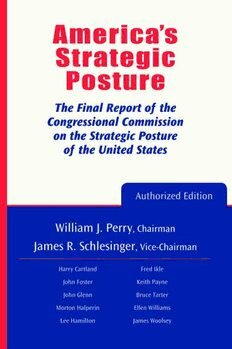
America's Strategic Posture: the final report of the Congressional Commission on the Strategic Posture of the United States PDF
180 Pages·2009·1.392 MB·English
Most books are stored in the elastic cloud where traffic is expensive. For this reason, we have a limit on daily download.
Preview America's Strategic Posture: the final report of the Congressional Commission on the Strategic Posture of the United States
Description:
How to secure the nuclear peace remains one of the most profound questions of the modern era. Twenty years after the end of the Cold War and with the arrival of a new administration in Washington, it is time to think through fundamental questions about the purposes of nuclear deterrence and the character of the U.S. strategic posture. While the existential threat to the United States has decreased, the rising threat of catastrophic terrorism, the possession and spread of nuclear weapons by other states, and a general worldwide nuclear renaissance continue to influence decisions about America s strategic posture. Recognizing the changing character of these threats, Congress formed a commission in 2008 to examine the United States long-term strategic posture and make recommendations. For more than eleven months this bipartisan commission of leading experts on national security, arms control, and nuclear technology met with Congressional leaders, military officers, high-level officials of several countries, arms control groups, and technical experts to assess the appropriate roles for nuclear weapons, nonproliferation programs, and missile defenses. This official edition contains a discussion of key questions and issues as well as the Commission s findings and recommendations for tailoring U.S. strategic posture to new and emerging requirements as the world moves closer to a proliferation tipping point.
See more
The list of books you might like
Most books are stored in the elastic cloud where traffic is expensive. For this reason, we have a limit on daily download.
